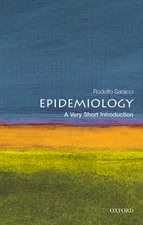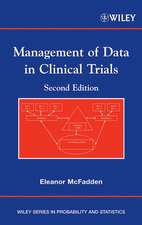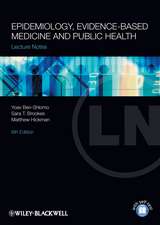Issues in Clinical Epileptology: A View from the Bench: Advances in Experimental Medicine and Biology, cartea 813
Editat de Helen E. Scharfman, Paul S. Buckmasteren Limba Engleză Paperback – 23 aug 2016
| Toate formatele și edițiile | Preț | Express |
|---|---|---|
| Paperback (1) | 1102.82 lei 6-8 săpt. | |
| SPRINGER NETHERLANDS – 23 aug 2016 | 1102.82 lei 6-8 săpt. | |
| Hardback (1) | 1111.46 lei 6-8 săpt. | |
| SPRINGER NETHERLANDS – 11 iul 2014 | 1111.46 lei 6-8 săpt. |
Din seria Advances in Experimental Medicine and Biology
- 9%
 Preț: 719.60 lei
Preț: 719.60 lei - 20%
 Preț: 691.93 lei
Preț: 691.93 lei - 5%
 Preț: 717.00 lei
Preț: 717.00 lei - 5%
 Preț: 716.28 lei
Preț: 716.28 lei - 5%
 Preț: 717.20 lei
Preț: 717.20 lei - 15%
 Preț: 640.24 lei
Preț: 640.24 lei - 5%
 Preț: 1113.83 lei
Preț: 1113.83 lei - 5%
 Preț: 715.71 lei
Preț: 715.71 lei - 5%
 Preț: 820.43 lei
Preț: 820.43 lei - 15%
 Preț: 641.38 lei
Preț: 641.38 lei - 5%
 Preț: 716.28 lei
Preț: 716.28 lei - 5%
 Preț: 523.99 lei
Preț: 523.99 lei - 5%
 Preț: 1031.00 lei
Preț: 1031.00 lei - 5%
 Preț: 717.00 lei
Preț: 717.00 lei - 5%
 Preț: 715.35 lei
Preț: 715.35 lei - 20%
 Preț: 1161.71 lei
Preț: 1161.71 lei - 5%
 Preț: 1170.51 lei
Preț: 1170.51 lei - 18%
 Preț: 1119.87 lei
Preț: 1119.87 lei - 5%
 Preț: 1288.48 lei
Preț: 1288.48 lei - 5%
 Preț: 1164.67 lei
Preț: 1164.67 lei - 5%
 Preț: 1101.73 lei
Preț: 1101.73 lei - 18%
 Preț: 1123.67 lei
Preț: 1123.67 lei - 5%
 Preț: 1435.64 lei
Preț: 1435.64 lei - 20%
 Preț: 1044.10 lei
Preț: 1044.10 lei - 18%
 Preț: 946.39 lei
Preț: 946.39 lei - 5%
 Preț: 292.57 lei
Preț: 292.57 lei - 18%
 Preț: 957.62 lei
Preț: 957.62 lei - 18%
 Preț: 1235.76 lei
Preț: 1235.76 lei - 5%
 Preț: 1231.55 lei
Preț: 1231.55 lei - 5%
 Preț: 1292.30 lei
Preț: 1292.30 lei - 5%
 Preț: 1102.10 lei
Preț: 1102.10 lei - 18%
 Preț: 1132.81 lei
Preț: 1132.81 lei - 5%
 Preț: 1165.19 lei
Preț: 1165.19 lei - 5%
 Preț: 1418.48 lei
Preț: 1418.48 lei - 5%
 Preț: 1305.63 lei
Preț: 1305.63 lei - 18%
 Preț: 1417.72 lei
Preț: 1417.72 lei - 18%
 Preț: 1412.99 lei
Preț: 1412.99 lei - 24%
 Preț: 806.16 lei
Preț: 806.16 lei - 18%
 Preț: 1243.29 lei
Preț: 1243.29 lei - 5%
 Preț: 1429.44 lei
Preț: 1429.44 lei - 5%
 Preț: 1618.70 lei
Preț: 1618.70 lei - 5%
 Preț: 1305.12 lei
Preț: 1305.12 lei - 18%
 Preț: 1124.92 lei
Preț: 1124.92 lei - 5%
 Preț: 1097.54 lei
Preț: 1097.54 lei - 15%
 Preț: 649.87 lei
Preț: 649.87 lei - 5%
 Preț: 1097.54 lei
Preț: 1097.54 lei - 18%
 Preț: 945.79 lei
Preț: 945.79 lei - 5%
 Preț: 1123.16 lei
Preț: 1123.16 lei
Preț: 1102.82 lei
Preț vechi: 1160.86 lei
-5% Nou
Puncte Express: 1654
Preț estimativ în valută:
211.01€ • 220.34$ • 174.26£
211.01€ • 220.34$ • 174.26£
Carte tipărită la comandă
Livrare economică 15-29 aprilie
Preluare comenzi: 021 569.72.76
Specificații
ISBN-13: 9789402407891
ISBN-10: 9402407898
Pagini: 360
Ilustrații: XXI, 339 p. 50 illus., 21 illus. in color.
Dimensiuni: 178 x 254 x 19 mm
Greutate: 0.63 kg
Ediția:Softcover reprint of the original 1st ed. 2014
Editura: SPRINGER NETHERLANDS
Colecția Springer
Seria Advances in Experimental Medicine and Biology
Locul publicării:Dordrecht, Netherlands
ISBN-10: 9402407898
Pagini: 360
Ilustrații: XXI, 339 p. 50 illus., 21 illus. in color.
Dimensiuni: 178 x 254 x 19 mm
Greutate: 0.63 kg
Ediția:Softcover reprint of the original 1st ed. 2014
Editura: SPRINGER NETHERLANDS
Colecția Springer
Seria Advances in Experimental Medicine and Biology
Locul publicării:Dordrecht, Netherlands
Cuprins
Preface.- Foreword.- Part I Seizures, epileptiform activities and regional localization.- How can we identify ictal and interictal abnormal activity?- How can we translate “epileptiform” activity in vitro into something that is clinically relevant?- What is the importance of abnormal “background” activity in seizure generation?- What is a seizure focus?- What is a seizure network? Very fast oscillations at the interface between normal and epileptic brain.- What is a seizure network? Long-range network consequences of focal seizures.- Is there any such thing as “generalized” epilepsy?- Part II Synaptic plasticity.- Are there really “epileptogenic” mechanisms or only corruptions of “normal” plasticity?- When and how do seizures kill neurons - and is cell death relevant to epileptogenesis?- How is homeostatic plasticity important in epilepsy?- Is plasticity of GABA ergic mechanisms relevant to epileptogenesis?- Do structural changes in GABA neurons give rise to the epileptic state?- Does mossy fiber sprouting give rise to the epileptic state?- Does brain inflammation mediate pathological outcomes in epilepsy?- Are changes in synaptic function that underlie hyperexcitability responsible for seizure activity?- Does epilepsy cause a reversion to immature function?- Are alterations in transmitter receptor and ion channel expression responsible for the epilepsies?- Part III Models and methods.- How do we assess the clinical relevance of models of mesial temporal lobe epilepsy?- How do we make models that are useful in understanding partial epilepsies?- What non-neuronal mechanisms should be studied to understand epileptic seizures?- What epilepsy comorbidities are important to model in the laboratory? Clinical perspectives.- Understanding epilepsy comorbidities: how can animal models help?- What new modeling approaches will help us identify promising drug treatments?- What are the arguments for and againstrational therapy for epilepsy?- How can advances in epilepsy genetics lead to better treatments and cures?- How might novel technologies such as optogenetics lead to better treatments in epilepsy?.
Textul de pe ultima copertă
This book is dedicated to Dr. Philip A. Schwartzkroin. The book has a novel format because it is not intended to be a set of reviews. Instead, it is an effort to explore important topics in the epilepsy research field. Because articles are written by leaders in the field who have years of experience, and individuals with diverse expertise, articles are likely to have a long-lasting impact and be relevant for both epileptologists and neuroscientists. Authors address topics that are important, unresolved questions in the field of epilepsy research, drawing on available data from both the bench and the clinic to support their points. A given topic is addressed by one or more authors, each writing from his/her own unique perspective.
For all of the individuals who have been trained or worked with Philip Schwartzkroin in the past, and/or have appreciated his contributions to the epilepsy field, this volume is an excellent way to celebrate his achievements and look to the ways they have moved the field forward, and continue to stimulate its growth.
For all of the individuals who have been trained or worked with Philip Schwartzkroin in the past, and/or have appreciated his contributions to the epilepsy field, this volume is an excellent way to celebrate his achievements and look to the ways they have moved the field forward, and continue to stimulate its growth.
Caracteristici
Discussion of current debates in epilepsy research Authors are leaders in the field of epilepsy and neuroscience Basic and clinical research opinions are combined Content provides a perspective on past literature Chapters suggest future directions in epilepsy research












